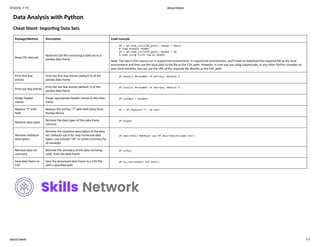Cheat-Sheets. Importing Data Sets in Python.pdf
- 1. Data Analysis with Python Cheat Sheet: Importing Data Sets Package/Method Description Code Example Read CSV data set Read the CSV file containing a data set to a pandas data frame df = pd.read_csv(<CSV_path>, header = None) # load without header df = pd.read_csv(<CSV_path>, header = 0) # load using first row as header Note: The labs in this course run in JupyterLite environment. In JupyterLite environment, you'll need to download the required file to the local environment and then use the local path to the file as the CSV_path. However, in case you are using JupyterLabs, or any other Python compiler on your local machine, you can use the URL of the required file directly as the CSV_path. Print first few entries Print the first few entries (default 5) of the pandas data frame df.head(n) #n=number of entries; default 5 Print last few entries Print the last few entries (default 5) of the pandas data frame df.tail(n) #n=number of entries; default 5 Assign header names Assign appropriate header names to the data frame df.columns = headers Replace "?" with NaN Replace the entries "?" with NaN entry from Numpy library df = df.replace("?", np.nan) Retrieve data types Retrieve the data types of the data frame columns df.dtypes Retrieve statistical description Retrieve the statistical description of the data set. Defaults use is for only numerical data types. Use include="all" to create summary for all variables df.describe() #default use df.describe(include="all") Retrieve data set summary Retrieve the summary of the data set being used, from the data frame df.info() Save data frame to CSV Save the processed data frame to a CSV file with a specified path df.to_csv(<output CSV path>) 3/12/24, 1:15 about:blank about:blank 1/1
